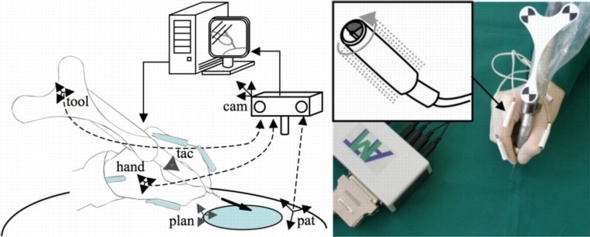Vibrotactile displays for surgical navigation
Vibrotactile displays for surgical navigation
Background and problem / need
During surgical navigation, the deviations between the pre-planned target position and the current actual position are visualised on a monitor (e.g. Stealth Station by Medtronic, Vector Vision by Brainlab). This optical feedback forces the surgeon to constantly switch his gaze between the operating area and the monitor. Particularly with very dynamic tasks, such as milling, inaccuracies can occur because the switch takes too long.
Robotic systems have been introduced to improve the quality of dynamic tasks in particular (RoboDoc from ISS, SurgiScope from Elekta, etc.). Further developments such as telemanipulation systems (daVinci by Intuitive Surgical) or interactive systems (Hein and Lüth, 2001) add the haptic channel to the feedback to the surgeon. The counterforce of the bone during a milling operation can be fed back to the surgeon by a force effect of the robot on the surgeon.
Vibrotactile feedback through so-called tactors (e.g. motors that generate vibrations on the skin) has already been used as an additional information channel between a technical assistance system and the user. Applications so far have been systems for biofeedback (Weissgerber et al., 2004), communication with the deaf and blind (Phillips et al., 1999) and directional indication for pilots and astronauts (Rupert, 2000). Van Erp (2005) described an approach for navigating subjects with tactors on the torso. It was shown that the subjects could interpret the stimuli on the torso as directional displays.
Approach
In this project, the application of vibrotactile feedback for surgical navigation is evaluated. In the first approach, the tactors were placed at non-interfering positions on the back of the hand and the hand or instrument was equipped with localisers for position determination. After calculating the difference between the target and actual position, stimuli are generated on the hand so that the user can directly detect the necessary corrective movement. 
The following questions are addressed:
- Modelling and controller design for vibrotactile navigation,
- Accuracy and dynamic behaviour of instrument positioning,
- clock arrangements and interpolation between clocks,
- Time-varying effects (learning curves, saturation, attention)
- Deviations between hand-internal and external coordinate systems.
Cooperations/Funding
The work is being carried out within the framework of the International Research Training Group Neurosensory Science and Systems (spokesperson: Prof. Dr. Dr. Birger Kollmeier).
Publications
Mungwe, S.; Hein, A. (2011): The Need for Adaptation in Vibrotactile Surgical Navigation. Proceedings of the 2011 SCATh Joint Workshop on New Technologies for Computer/Robot Assisted Surgery, July 11-13, 2011, Graz, Austria, pp. 1-4.
Mungwe, S.A.; Hein, A. (2011): Fuzzy Controller for Positioning Tasks in Tactile Surgical Navigation. International Conference on Control, Robotics and Cybernetics (ICCRC 2011). New Delhi, India, March 19-20, 2011, pp. V1-289-292.
Mungwe, S.A.; Hein, A. (2010): Accuracy Analysis in Positioning and Milling with a Tactile Surgical Navigation System. 1st International Conference on Applied Bionics and Biomechanics- ICABB-2010, Venice, Italy, October 14-16, 2010, 6 pages.
Mungwe, S.; Hein, A. (2010): Adaptive Controller for a Tactile Surgical Navigation System. Proc. of the 7th IASTED Int. Conf. Biomedical Engineering (BioMED 2010), Feb., 17-19, 2010 Innsbruck, Austria, pp. 160-163.
Brell, M. (2009): A vibrotactile human-machine interface for surgical applications. Dissertation at the University of Oldenburg. Fortschr.-Ber. VDI Series 17 No. 276. Düsseldorf: VDI Verlag 2009.
Brell, M.; Hein, A. (2009): Tactile guidance in multimodal computer navigated surgery. IEEE Potentials, Volume: 28 Issue:4, pp. 30 - 35.
Isken, M.; Brell, M.; Hein, A. (2008): Wireless signal transmission for tactile surgical navigation. 7th Annual Meeting of the German Society for Computer and Robot Assisted Surgery, Germany, Leipzig, September 24-26, 2008
Hein, A.; Brell, M. (2008): Multimodal human-machine interfaces for surgical navigation. 39th Annual Meeting of the DGMP, Germany, Oldenburg, September 10-13, 2008, in print.
Brell, M.; Roßkamp, D.; Hein, A. (2008): Fusion of Vibrotactile Signals used in a Tactile Display in Computer Aided Surgery. EuroHaptics 2008, Madrid, Spain, June 11-13, 2008, in print
Brell M., Hein A.: Multimodal Navigation with a Vibrotactile Display in Computer Assisted Surgery. In: Lee, S.; Suh, I.H.; Kim, M.S. (Eds.): Recent Progress in Robotics; Viable Robotic Service to Human. Edition of Selected Papers from the 13th International Conference on Advanced Robotics (ICAR 2007). Lecture Notes in Control and Information Sciences (LNCIS), Volume 370, , ISBN 978-3-540-76728-2, Springer (2008) 331 - 343.
Brell, M.; Hein, A. (2007): Preliminary investigation on vibrotactile controlled instrument guidance for multimodal assisted navigation. 6th Annual Meeting of the German Society for Computer and Robot Assisted Surgery (CURAC), Karlsruhe, 11-13 October 2007, pp. 173-176.
Brell, M.; Hein, A. (2007): Positioning Tasks in Multimodal Computer Navigated Surgery. IEEE MultiMedia Magazine - Special Issue on Multimedia Signal Processing and Systems in Healthcare and Life Sciences, Oct.-Dec. 2007, pp 42-51. Hein A., Brell M. (2007): conTACT - A Vibrotactile Display for Computer Aided Surgery. Second Joint Eurohaptics Conference and Symposium on Haptic Interfaces for Virtual Environment and Teleoperator Systems (WHC2007), Tsukuba, Japan, March 22 - 24, 2007, pp 531-536.
Hein, A., Brell, M. (2006): Navigation device and navigation method for a tool, in particular a medical instrument. DE patent application 102006045100.7; disclosure: 10.04.2008.
